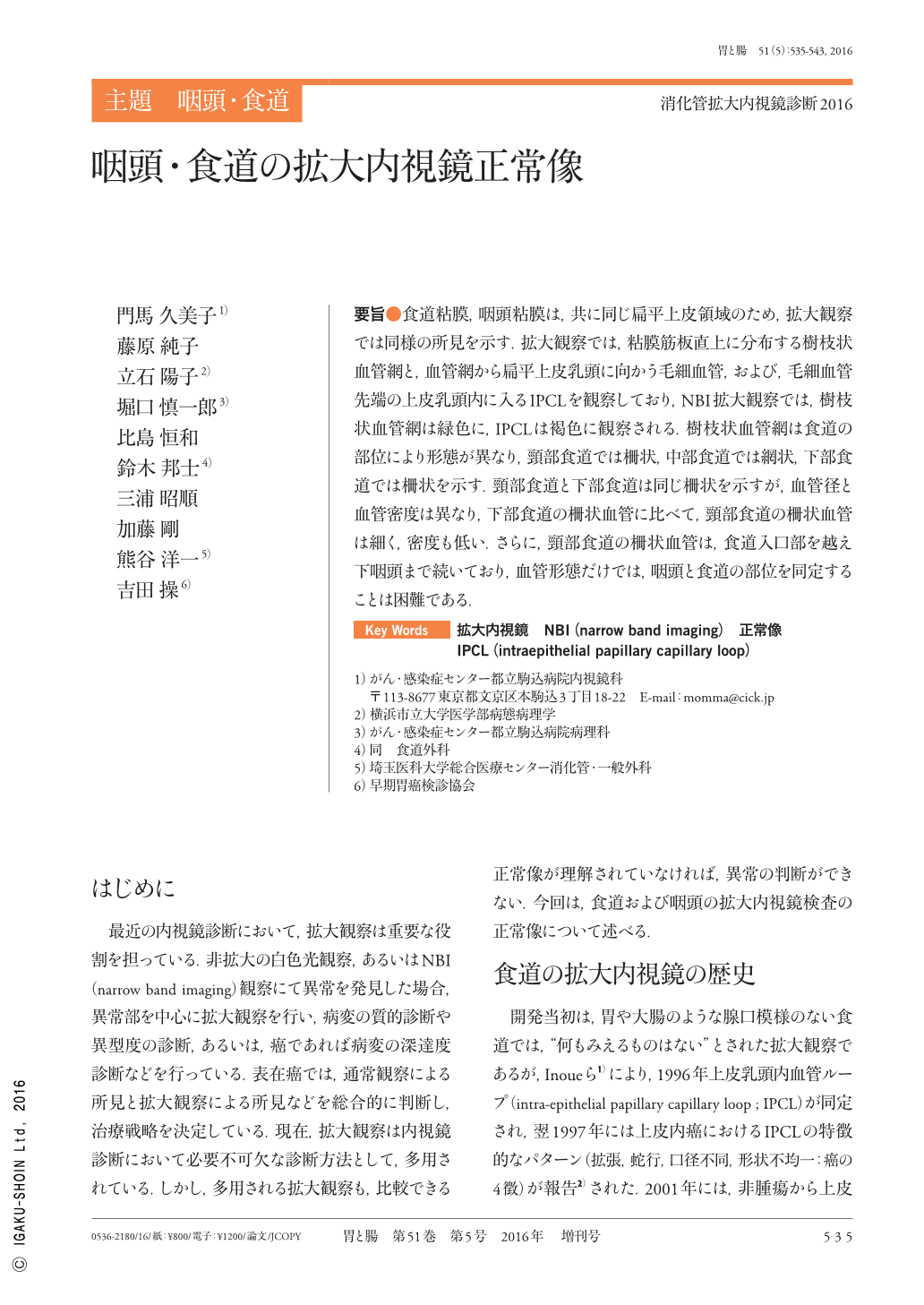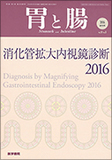Japanese
English
- 有料閲覧
- Abstract 文献概要
- 1ページ目 Look Inside
- 参考文献 Reference
- サイト内被引用 Cited by
要旨●食道粘膜,咽頭粘膜は,共に同じ扁平上皮領域のため,拡大観察では同様の所見を示す.拡大観察では,粘膜筋板直上に分布する樹枝状血管網と,血管網から扁平上皮乳頭に向かう毛細血管,および,毛細血管先端の上皮乳頭内に入るIPCLを観察しており,NBI拡大観察では,樹枝状血管網は緑色に,IPCLは褐色に観察される.樹枝状血管網は食道の部位により形態が異なり,頸部食道では柵状,中部食道では網状,下部食道では柵状を示す.頸部食道と下部食道は同じ柵状を示すが,血管径と血管密度は異なり,下部食道の柵状血管に比べて,頸部食道の柵状血管は細く,密度も低い.さらに,頸部食道の柵状血管は,食道入口部を越え下咽頭まで続いており,血管形態だけでは,咽頭と食道の部位を同定することは困難である.
Recent advances in magnifying endoscopy assisted by NBI(narrow band imaging)have enabled us to study the vascular system of the esophageal mucosa in great detail. Abnormalities in the number, size, shape, and distribution of small vessels in the mucosa yield important information in terms of pathological changes. In the present paper, we provide an overview of blood vessel structures in the normal esophageal mucosa seen using magnifying endoscopy and NBI.
Magnifying endoscopy and NBI revealed two small vascular networks in different mucosal layers, which communicate with each other and create a stratified vascular network. There are vascular networks in the lower part of the lamina propria(LPM)and in the upper part of the LPM close to the squamous epithelium. NBI observation revealed that blood vessels of the vascular networks in the LPM are composed of small vessels exhibiting differences in size, shape, and color. Vessels in the lower LPM networks are larger in size than those in the upper LPM and they can be recognized by NBI as brown-colored vessels. Vascular networks in the lower LPM can also be recognized by conventional endoscopy as a reticular vascular network in the esophageal mucosa and as palisade vessels at the pharyngoesophageal and esophagogastric junctions. These structures are recognized by NBI as brown-colored blood vessels. The size of the network vessels in the lower LPM lies between those of SM and capillary vessels. Vesssels in SM are recognized as green vessels in NBI observation and larger in size than those of LPM vessels. Palisade vessels are dense in the lower esophagus while they are narrow and coarse in the esophageal orifice. Endoscopically, the esophagogastric junction can be identified as a lower margin of palisade vessels. Palisade vessels in the lower pharynx are frequently connected to palisade vessels in the upper esophagus, making endoscopic identification of the pharyngoesophageal junction difficult via the simple observation of mucosal vessels. Capillary vessels branch off from the lower LPM vascular network, creating capillary vascular networks close to the squamous epithelium(sub-epithelial capillary network ; SCN). Finally, capillary vessels branch off from SCN and enter into LPM of the epithelial papilla in the esophageal mucosa. These vessels then return to SCN or lower LPM network, thus, creating a capillary loop(intra-epithelial papillary capillary loop). The pharyngeal mucosa is also covered by stratified squamous epithelium, which has almost the same vascular structure as that of the esophageal mucosa.

Copyright © 2016, Igaku-Shoin Ltd. All rights reserved.


